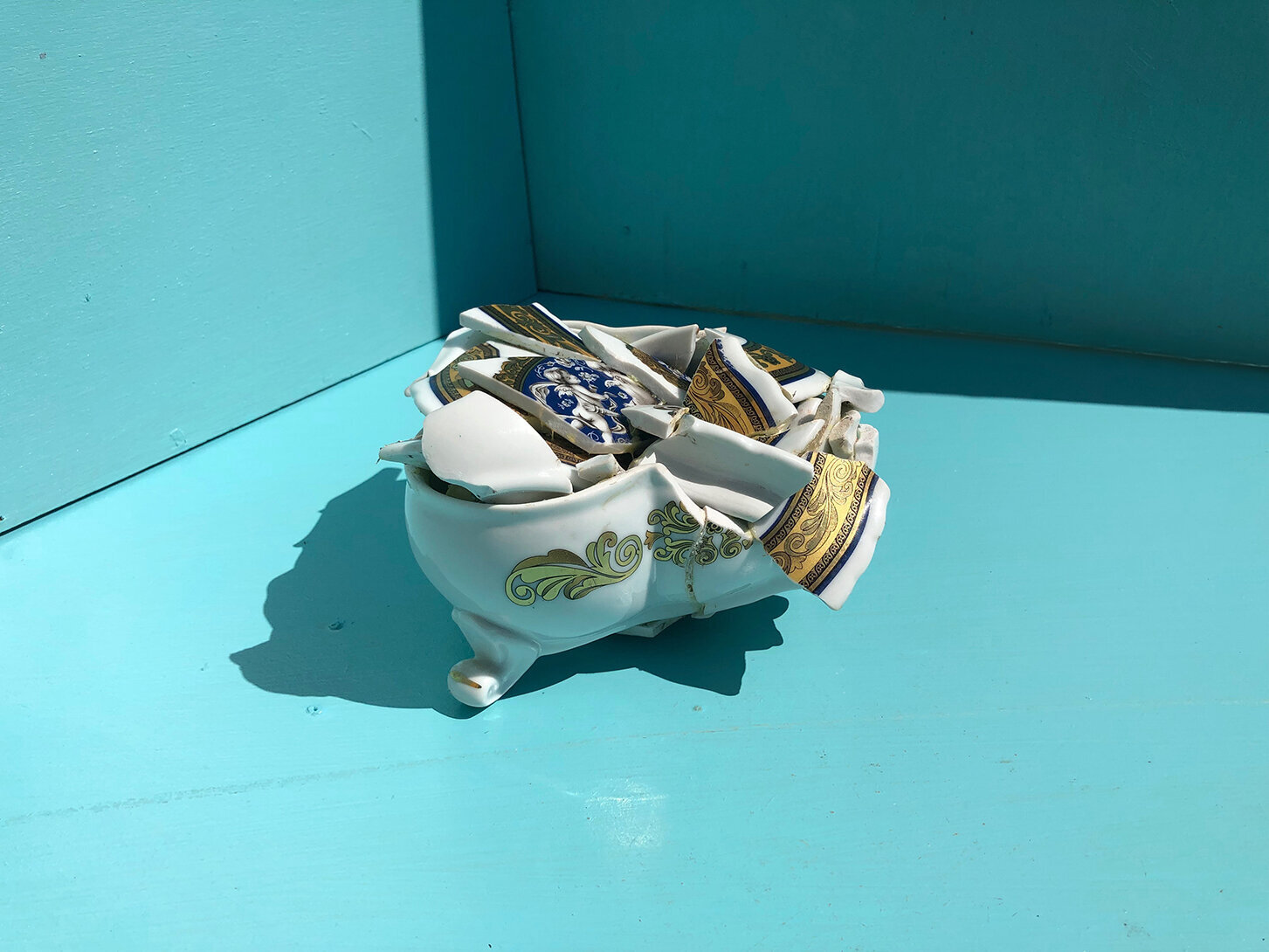Defunctionalizations
It is a concept conceived in 1984-85, and the concept of “Meaning” as a term of coding and common reference is explored. The meaning depends solely on the purpose. The meaning of a functioning object will not be the same as an object that is intentionally broken and deprived of its function. Breaking the object automatically erases its meaning. The object in its original form is defined as “A-intact” with its meaning “B-coherent”. The broken object becomes “A-mutated” while “B-coherent”, the original meaning, is canceled out. The object separated from its function and meaning takes on a new morphology and a new ontological determination. Its new aesthetic becomes its new meaning and its new function. And it can be called “C-native”. The result is an aesthetic and conceptual distortion, caused by the morphological memory of the object in its original "A-intact" state. Because, despite the evident new meaning and function, the mind continues to recognize the previous morphology, due to the mnemonic information connected to its "former" meaning.
The Analysis of Objectual Defunctionalization in Rospigliosi: A Semiological and Ontological Perspective
Rospigliosi's approach, within the scope of "Defunctionalizations," offers a rigorous analytical framework for studying the nature of objectual meaning, examining how it is linked to function and how its alteration leads to semiotic and ontological transformations. The conceptual starting point is the idea that meaning does not constitute an intrinsic property of the object, but rather a variable dependent on its specific function within a given system. This perspective, rooted in functionalism, implies that objectual signification is not static, but dynamic and relational, resulting from the object's interaction with its context of use. In this model, an object in its functional condition, designated as "A-intact," is associated with a "B-coherent" meaning. This coherence is generated by the congruence between the object's formal structure and its predetermined operational role. For example, a cutting tool possesses a coherent signification in relation to its effectiveness in performing the act of cutting, while a seat is defined in relation to its capacity to support the human body in a seated position. This correspondence between form and function generates a signification that is immediately intelligible and shared within a community of users. Rospigliosi, however, introduces a perturbing variable: the intentional compromise of the objectual function through the act of breaking. This operation, defined as "defunctionalization," is not limited to the mere physical destruction of the object, but entails a radical deconstruction of its original meaning. The transformed object, now "A-mutated," loses its "B-coherence," that is, its primary purpose. The damaged cutting tool is no longer capable of cutting, and the destroyed seat no longer fulfills its supporting function. The loss of function triggers a semiological deconstruction, forcing the observer to reconsider the ontological coordinates of the object. Nevertheless, this "death" of the original meaning initiates a process of semiotic and ontological recomposition. The defunctionalized object does not vanish into oblivion; on the contrary, it undergoes a metamorphosis, acquiring a new morphology and a new ontological determination. The object, deprived of its original destination, becomes "C-native." This new "nativity" is not a simple reiteration of a pre-existing model, but a true re-signification. Its new aesthetic configuration, its unprecedented way of manifesting itself, becomes its new meaning and its new function. The scrapped object, freed from its primary utility, is liberated from the restrictions of its initial destination to assume a new value, a new role in the relational system that encompasses it. However, this process of defunctionalization and re-signification does not manifest without consequences. A cognitive and aesthetic distortion is generated, deriving from the comparison between the current configuration of the object and its initial "A-intact" form. The subject, while being able to identify the new meaning, cannot disregard the comparison with the object's previous state, due to the mnemonic information related to its original function. This comparison triggers a perceptual conflict that hinders the enjoyment of the defunctionalized object with the same spontaneity and immediacy with which the experience of a functioning object is approached. Perception, in this sense, is influenced by the memory of the object's past, as if the shadow of its original signification continued to project onto its new form. This perturbation, however, does not represent a limitation, but rather a propulsive factor for analysis. The tension between old and new, between lost function and rediscovered form, creates an epistemological space suitable for reflection, interpretation, and the generation of new meanings. Defunctionalization, in this sense, can be interpreted as an act of liberation, through which objects transcend the reification of utilitarianism to project themselves into a new aesthetic and conceptual dimension. Rospigliosi's analysis is not limited to the mere description of a process, but invites a critical revision of the subject-object relationship, soliciting the investigation of the nature, value, and history of each entity. In conclusion, it proposes to review the world through a new perspective, ready to capture complexity even in alteration, in the fragment, in what appears unused. In summary, Rospigliosi's theory of defunctionalization highlights how meaning is not an objective and permanent property, but a dynamic and relational process, closely dependent on the function and use of objects. Breakage, far from being a mere destructive act, is configured as an engine of transformation and renewal, guiding objects towards new forms of expression and meaning. Through this path, Rospigliosi invites us to a critical analysis of our perceptual and interpretive modalities of reality, proposing an original and stimulating vision on the role of objects in the configuration of our phenomenological world.
Ex work of art 6 (Defunctionalization). 1985©. 50x60 > 50x30 cm, oil on canvas subsequently broken. Photograph of the installation 100x150 cm, digital print on plexiglass.
16f (Defunctionalization). 2003 ©. Cm 17x16x11, porcelain and gold. Photographs of the installation 100x150 cm, print on plexiglass.
Former soup tureen (Defunctionalization). 2003©. Cm 30x23x16, porcelain and gold. Photographs of the installation 100x150 cm, print on plexiglass.
Losing one's function creates anxiety p3 (Defunctionalization). 2007©. Cm 20x21x10, 1905 psychology book, string, sealing wax. Photographs of the installation 100x150 cm, print on plexiglass.
Losing one's function creates anxiety n° 75 (Defunctionalization). 2009©. Cm 39x32x20, wood, glass, cut keys, string and sealing wax.
Losing one's function creates anxiety n° 34 (Defunctionalization). 2009©. Cm 45 x32 x21, wood, glass, hammer cut into pieces, string and sealing wax.
Losing one's function creates anxiety n° 19 (Defunctionalization). 2009©. Cm 41x30x16, wooden container, fabric, brass, glass, cut keys, sealing wax, string, enamel.
Defunctionalization of the 5 (Defunctionalization). 2007©. 18x15x10 cm, porcelain. Photographs of the installation, Cm 100x150, digital printing on plexiglass.
Defunctionalized 8 (Defunctionalization). 2016-2017©. Cm 18x4x10, Fork, spoon and knife cut, string and sealing wax. Photographs of the installation 100x150 cm, digital printing on plexiglass.
Defunctionalized 16f (Defunctionalization). 2003©. Cm 17x16x11, porcelain, brass. Photographs of the installation 100x150 cm, digital printing on plexiglass.
Former Teapot (Defunctionalization). 2002©. Cm 19x18x18, porcelain, mirror. Photographs of the installation 100x150 cm, digital printing on plexiglass.
Defunctionalized 7 (Defunctionalization). 2006©. 20x20 cm, cut glasses, wood, enamel. Photograph of the installation 100x150 cm, digital printing on plexiglass.
Losing one's function creates anxiety 1x (Defunctionalization). 2001©. Cm 60x12, saw for wood whose teeth have been removed. Photographs of the installation 100x150 cm, digital printing on plexiglass.
Losing one's function creates anxiety 25 (Defunctionalization). 2016-2017©. Cm 18x4x10, fork, spoon and knife cut out, black pencil, string and sealing wax. Photograph of the installation 100x150 cm, digital printing on plexiglass.
Losing one's function creates anxiety 21 (Defunctionalization). 2009©. Cm 9x2, cut iron chisel, string, sealing wax. Photograph of the installation 100x150 cm, digital printing on plexiglass.
Study on defunctionalization 4d (Defunctionalization). 2016-2017©. Cm 34x25x16, wood, clay, cut glasses. Photograph of the installation 100x150 cm, digital printing on plexiglass.
Losing one's function creates anxiety d (Defunctionalization). 2009©. Cm 20x8, cut iron chisel, string, sealing wax. Photograph of the installation 100x150 cm, digital printing on plexiglass.
Privacy Policy Image Licensing
All rights reserved Virgilio Rospigliosi 2023© Design by Lux Aeterna Multimedia










































